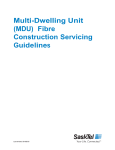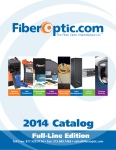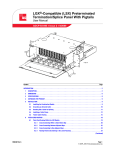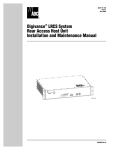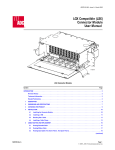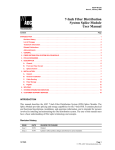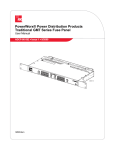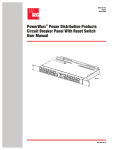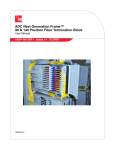Download ADC ADCP-90-216 User manual
Transcript
ADCP-90-328 • Issue 2 • November 2005 FPL Series Termination/Splice Panel User Manual) 2 8 14 20 26 3 32 9 42 15 48 21 54 27 4 60 33 10 66 38 16 72 44 22 50 28 5 56 34 11 62 39 17 68 45 23 51 29 6 57 35 12 63 40 18 69 46 24 52 30 58 36 64 41 70 47 53 59 65 42 71 48 54 60 66 72 17807-A FPL Termination/Splice Panel Content Page INTRODUCTION . . . . . . . . . . . . . . . . . . . . . . . . . . . . . . . . . . . . . . . . . . . . . . . . . . . . . . . . . . . . . . . . . . . . . . . . . . . . . 2 Revision History . . . . . . . . . . . . . . . . . . . . . . . . . . . . . . . . . . . . . . . . . . . . . . . . . . . . . . . . . . . . . . . . . . . . . . . . 2 Trademark Information . . . . . . . . . . . . . . . . . . . . . . . . . . . . . . . . . . . . . . . . . . . . . . . . . . . . . . . . . . . . . . . . . . . 2 1 DESCRIPTION . . . . . . . . . . . . . . . . . . . . . . . . . . . . . . . . . . . . . . . . . . . . . . . . . . . . . . . . . . . . . . . . . . . . . . . . . . 2 2 ACCESSORIES . . . . . . . . . . . . . . . . . . . . . . . . . . . . . . . . . . . . . . . . . . . . . . . . . . . . . . . . . . . . . . . . . . . . . . . . . 8 3 SPECIFICATIONS AND DIMENSIONS . . . . . . . . . . . . . . . . . . . . . . . . . . . . . . . . . . . . . . . . . . . . . . . . . . . . . . . . . . 8 4 APPLICATION . . . . . . . . . . . . . . . . . . . . . . . . . . . . . . . . . . . . . . . . . . . . . . . . . . . . . . . . . . . . . . . . . . . . . . . . . 13 5 INSTALLATION . . . . . . . . . . . . . . . . . . . . . . . . . . . . . . . . . . . . . . . . . . . . . . . . . . . . . . . . . . . . . . . . . . . . . . . . 14 5.1 Installing Adapters . . . . . . . . . . . . . . . . . . . . . . . . . . . . . . . . . . . . . . . . . . . . . . . . . . . . . . . . . . . . . . . 14 5.2 Installing Pigtails . . . . . . . . . . . . . . . . . . . . . . . . . . . . . . . . . . . . . . . . . . . . . . . . . . . . . . . . . . . . . . . . 15 5.3 Mounting the Panel on the Rack . . . . . . . . . . . . . . . . . . . . . . . . . . . . . . . . . . . . . . . . . . . . . . . . . . . . . . 18 5.4 Installing OSP or IFC Cable. . . . . . . . . . . . . . . . . . . . . . . . . . . . . . . . . . . . . . . . . . . . . . . . . . . . . . . . . . 19 5.5 Splicing . . . . . . . . . . . . . . . . . . . . . . . . . . . . . . . . . . . . . . . . . . . . . . . . . . . . . . . . . . . . . . . . . . . . . . . 22 (continued) 1345101 Rev A Page 1 © 2005, ADC Telecommunications, Inc. ADCP-90-328 • Issue 2 • November 2005 Content (continued) 5.6 Page Installing FOT Patch Cords . . . . . . . . . . . . . . . . . . . . . . . . . . . . . . . . . . . . . . . . . . . . . . . . . . . . . . . . . . 28 5.6.1 Interconnect Application . . . . . . . . . . . . . . . . . . . . . . . . . . . . . . . . . . . . . . . . . . . . . . . . . . . . 28 5.6.2 Cross-Connect Application . . . . . . . . . . . . . . . . . . . . . . . . . . . . . . . . . . . . . . . . . . . . . . . . . . . 29 6 OPERATION (CROSS-CONNECT PATCH CORDS) . . . . . . . . . . . . . . . . . . . . . . . . . . . . . . . . . . . . . . . . . . . . . . . . . 30 7 CUSTOMER INFORMATION AND ASSISTANCE . . . . . . . . . . . . . . . . . . . . . . . . . . . . . . . . . . . . . . . . . . . . . . . . . . . 32 APPENDIX A: SHIELD CONNECTOR INSTALLATION . . . . . . . . . . . . . . . . . . . . . . . . . . . . . . . . . . . . . . . . . . . . . . . . . . . . 33 _________________________________________________________________________________________________________ INTRODUCTION This user manual describes the FPL Series Termination/Splice Panel, and provides all information required to install and operate this product. All FPL panels can be mounted on either a 19-inch or 23-inch WECO or EIA rack. Revision History quad cables and patch cord routing ISSUE DATE REASON FOR CHANGE Issue 1 07/2002 Original. Issue 2 11/2005 Added 1RU 12/24 position panels. Trademark Information ADC is a registered trademark of ADC Telecommunications, Inc. 1 DESCRIPTION The FPL Series Termination/Splice Panel documented in this manual may be any of a number of rack-mounted panels built using the same chassis style and incorporating similar features such as angled adapters and vertical cable guides. Panel configurations include the following: • Termination Only Panels—Available with 12, 24, 48, 72, or 96 termination positions. LX.5 and LC connectors may be used with the 12, 24, 48, and 72 position panels to double the density. These panels require connectorized fibers on both sides of the termination bulkhead. • Termination and Splice Panels—Available with 12, 24, 48, 72, or 96 termination positions. LX.5 and LC connectors may be used with the 12, 24, 48, and 72 position panels to double the density. These panels provide a transition between bare fibers and connectorized fibers. • High Density Termination and Splice Panel—Provides 144 termination and splice positions in the same chassis, using standard connector types. The bulkhead on this panel is slanted inward in a “V” design to provide room for a greater number of adapters. Page 2 © 2005, ADC Telecommunications, Inc. ADCP-90-328 • Issue 2 • November 2005 Figure 1 shows an example of a termination only panel, the 72 position model. Other models have analogous features. ANGLED ADAPTERS ADJUSTABLE MOUNTING BRACKET FPL CHASSIS ADJUSTABLE MOUNTING BRACKET CABLE CLAMP ASSEMBLY VERTICAL CABLE GUIDE 2 8 14 20 26 3 32 9 42 15 48 21 54 27 4 60 33 10 66 38 16 72 44 22 50 28 5 56 34 11 62 39 17 68 45 23 51 29 6 57 35 12 63 40 18 69 46 24 52 30 58 36 64 41 70 47 53 59 TERMINATION BULKHEAD 65 42 71 48 54 60 66 72 CABLE CLAMP COVER REMOVABLE FRONT DOOR VERTICAL CABLE GUIDE OPTIONAL LOCK MOUNT 17816-A PATCH CORD DESIGNATION CARD Figure 1. 72 Position Termination Only Panel The features called out are as follows (from top center clockwise): • FPL Chassis—is the boxlike, solid metal frame on which the panel is built. The chassis shown is 8.7 inches (22.1 cm) high, 16.4 inches (41.7 cm) wide, and 12.0 inches (30.5 cm) deep. This same chassis is also used for the 48 and 96 position panels, as well as for the 48, 72, and 96 position termination and splice panels. Shorter-height chassis are used for the 12 and 24 position panels and a deeper chassis is used for the 144 position high density panel. For details, refer to Table 1 on Page 8. • Adjustable Mounting Bracket—(one on each side) can be oriented to provide either 19inch or 23-inch WECO or EIA rack mounting with either a 4-inch or 5-inch recess. The panel is shipped with the mounting brackets positioned for installation in a 19-inch rack with a 5-inch recess. • Cable Clamp Assembly—is a kit used to clamp a cable to the panel. Two cable clamp assemblies are provided with every FPL panel. Each clamp can accommodate a maximum cable diameter of 0.80 inch (2.03 cm). A grounding lug is included with each cable clamp for use if needed. Page 3 © 2005, ADC Telecommunications, Inc. ADCP-90-328 • Issue 2 • November 2005 • Cable Clamp Cover—protects cable at entry to the panel (not present on 12 and 24 position panels). • Vertical Cable Guide—(one on each side) is a metal cable retainer designed to provide cable management by confining and directing patch cords to and from the panel and along the frame on which the panel is installed. • Patch Cord Designation Card—is a laminated card fastened to the inside of the panel front door. The designation card is used to record the near-end and far-end termination locations of each patch cord installed on the panel. • Optional Lock Mount—provides ability to lock front door. • Removable Front Door—protects the termination bulkhead and can be removed to provide access to the bulkhead for connecting patch cords. • Termination Bulkhead—provides a location for connecting patch cords. The bulkhead shown has 72 holes for 72 adapters. Other bulkheads for the chassis size shown provide 48 or 96 locations for mounting connectors. • Angled Adapters—are pass-through receptacles for connectors. They are angled to either left or right to hold terminated fibers at an angle with respect to the bulkhead. The purpose of the angle is prevent fiber bend. Figure 2 and Figure 3 show the 48 and 96 position panels, respectively. Figure 4 shows the three rack unit 24 position panel. Figure 5 shows the one rack unit 12/24 position panel. 01 07 13 19 02 08 14 25 20 31 03 37 09 43 15 26 21 32 04 38 10 44 16 27 22 33 05 39 11 45 17 28 23 34 06 40 12 46 18 29 24 35 41 47 30 36 42 48 17808-A Figure 2. 48 Position FPL Termination Panel Page 4 © 2005, ADC Telecommunications, Inc. ADCP-90-328 • Issue 2 • November 2005 1 7 13 19 25 31 2 37 8 43 14 20 26 32 3 38 9 49 44 15 55 61 21 67 27 73 33 4 39 10 79 50 45 16 85 56 91 62 22 68 28 74 34 5 40 11 51 46 17 80 86 57 92 63 23 69 29 75 35 6 41 12 81 52 47 18 87 58 93 64 24 70 30 76 36 42 82 53 48 88 59 94 65 71 77 83 54 89 60 95 66 72 78 84 90 96 17815-A Figure 3. 96 Position FPL Termination Panel 06 12 18 24 02 05 08 30 11 36 03 42 06 48 09 14 12 17 20 23 15 18 21 24 17820-A Figure 4. 24 Position FPL Termination Panel (3RU) Page 5 © 2005, ADC Telecommunications, Inc. ADCP-90-328 • Issue 2 • November 2005 20973-A Figure 5. 12/24 Position FPL Termination Panel (1RU) Figure 6 shows a rear view of a termination and splice panel. The panel shown is the 72 position termination and splice panel. SPLICE AREA INTERNAL PIGTAIL 17819-A SPLICE TRAY OPTIONAL LOCK MOUNT REMOVABLE REAR ACCESS DOOR Figure 6. FPL Termination and Splice Panel Page 6 © 2005, ADC Telecommunications, Inc. ADCP-90-328 • Issue 2 • November 2005 The front side of the 72 position termination and splice panel is identical to the termination only panel shown in Figure 1. In general, the termination components of any FPL termination and splice panel are identical to the termination components of the panel’s termination and splice panel counterpart. Only the splice components are different. Figure 6 on the preceding page shows the typical components unique to the splice function of a termination and splice panel. They are as follows (from left to right in the figure): • Splice Area—is a protected chamber within the chassis intended for splice trays. In termination only panels, this area can be used for cable storage. • Internal Pigtail—is a factory-installed fiber optic cable with a connector at one end and a bare fiber on the other end. The connector end of the pigtail is terminated on the rear side of the termination bulkhead. The bare end of the pigtail is available for splicing to a bare fiber at the customer site. The cable from which the bare fibers are broken out for splicing may be either Outside Plant (OSP) or Intra Facility Cable (IFC). • Splice Tray—is a tray installed in the splice area. Each tray holds one or more splice chips of a selected type. • Removable Rear Access Door—provides access to the splice area. • Optional Lock Mount—provides ability to lock rear access door. Figure 7 shows the 144 position high density termination and splice panel. Additional features called out here are the split termination bulkhead, which provides the room required for the greater number of adapters, and the splice area access door, which opens into a locked horizontal position to serve as a splice deck. SPLICE AREA ACCESS DOOR SPLIT TERMINATION BULKHEAD 17906-A Figure 7. 144 Position High Density Termination and Splice Panel Page 7 © 2005, ADC Telecommunications, Inc. ADCP-90-328 • Issue 2 • November 2005 2 ACCESSORIES The following accessory items may be ordered separately for FPL panels: • Single and dual splice trays (for types, see Splice Type in Table 1 below) • Additional kits for clamping and grounding cables • Key locks for front and rear doors • Buildout attenuators (ST and biconic) • Bulkhead attenuators (ST, SC, D4, FC, and biconic) 3 SPECIFICATIONS AND DIMENSIONS Table 1 lists specifications for the FPL modules. Table 1. FPL Modules Specifications PARAMETER SPECIFICATION Common to All Panels Rack mounting 19-inch (48.26 cm) or 23-inch (58.42 cm) Hole spacing EIA or WECO Recess options 4-inch (10.16 cm) or 5-inch (12.7 cm) recess Connector types Multimode SC, SC duplex, ST©, LX.5©, and LC; Singlemode FC, FC (zirconia adapter), FC (8o polish), SC, SC (zirconia adapter), SC (8o polish), SC duplex, ST©, ST© (zirconia adapter), E-2000 (8o polish), E-2000 (flat polish), LX.5©, LC Pigtail type Stranded or ribbon Splice type Bare fusion, heat shrink fusion, mechanical, rotary, FibrLok, Raychem Universal (R), Nortel, AFL Pre-termination (optional) cable types Multimode IFC stranded 62.5/125; Singlemode IFC stranded, IFC plenum stranded, OSP single armor stranded, indoor-outdoor, OSP dielectric stranded, IFC Maxi-Strip, IFC ribbon, OSP single armor ribbon, OSP dielectric ribbon 12/24 Position Panel (1RU) Dimensions (H x W x D) 1.72 inch x 17.0 in. x 11.48 in. (4.4 cm x 43.2 cm x 29.2 cm) Capacity 12 or 24 termination positions LX.5© and LC connectors double the termination capacity 24 Position Panel (3RU) Dimensions (H x W x D) 5.0 inch x 16.4 in. x 12.0 in. (12.7 cm x 41.7 cm x 30.5 cm) Capacity 24 termination positions LX.5© and LC connectors double the termination capacity Page 8 © 2005, ADC Telecommunications, Inc. ADCP-90-328 • Issue 2 • November 2005 Table 1. FPL Modules Specifications PARAMETER SPECIFICATION 48/72/96 Position Panel (5RU) Dimensions (H x W x D) 8.7.0 inch x 21.9 in. x 12.0 in. (22.1 cm x 56.7 cm x 30.5 cm) Capacity 48, 72, or 96 termination positions LX.5© and LC connectors double the termination capacity 144 Position High Density Panel (5RU) Dimensions (H x W x D) Depth with rear door splice deck open 8.7.0 inch x 21.9 in. x 15.0 in. (22.1 cm x 56.7 cm x 38.1 cm) 23.0 inch (58.42 cm) Capacity 144 termination positions Figure 8 shows dimensions for the 12/24 position 1RU panel. 11.48 IN. (29.2 CM) 4.86 IN. (12.3 CM) TOP VIEW 17.0 IN. (43.2 CM) 20.24 IN. (51.4 CM) 22.32 IN. (56.7 CM) 23-IN. RACK MOUNT (58.4 CM) 1.72 IN. (4.4 CM) 1.25 IN. (3.2 CM) 18.32 IN. (46.5 CM) 19-IN. RACK MOUNT (48.3 CM) FRONT VIEW 20959-A Figure 8. 12/24 Position 1RU Panel Page 9 © 2005, ADC Telecommunications, Inc. ADCP-90-328 • Issue 2 • November 2005 Figure 9 shows dimensions of the 24 position 3RU panel. 12.0 IN. (30.5 CM) 5.0 IN. (12.7 CM) TOP VIEW 16.4 IN. (41.7 CM) 21.9 IN. (55.5 CM) 22.32 IN. (56.7 CM) 23-IN. RACK MOUNT (58.4 CM) 18.32 IN. (46.5 CM) 19-IN. RACK MOUNT (48.3 CM) 4.0 IN. (10.2 CM) 2.25 IN. (5.7 CM) 5.0 IN. (12.7 CM) FRONT VIEW Figure 9. Panel Dimensions (24 Position 3RU) Page 10 © 2005, ADC Telecommunications, Inc. 17822-A ADCP-90-328 • Issue 2 • November 2005 Figure 10 shows dimensions of the 48/72/96 position panel. 12.0 IN. (30.5 CM) 5.0 IN. (12.7 CM) TOP VIEW 16.4 IN. (41.7 CM) 21.9 IN. (55.5 CM) 22.32 IN. (56.7 CM) 23-IN. RACK MOUNT (58.4 CM) 18.32 IN. (46.5 CM) 19-IN. RACK MOUNT (48.3 CM) 8.7 IN. (22.1 CM) 4.0 IN. (10.2 CM) 2.25 IN. (5.7 CM) 5.0 IN. (12.7 CM) FRONT VIEW 17821-A Figure 10. Panel Dimensions (48/72/96 Position) Page 11 © 2005, ADC Telecommunications, Inc. ADCP-90-328 • Issue 2 • November 2005 Figure 11 shows dimensions of the 144 position high density panel 15.0 IN. (38.1 CM) 5.0 IN. (12.7 CM) TOP VIEW 16.4 IN. (41.7 CM) 21.9 IN. (55.5 CM) 22.32 IN. (56.7 CM) 23-IN. RACK MOUNT (58.4 CM) 18.32 IN. (46.5 CM) 19-IN. RACK MOUNT (48.3 CM) 8.7 IN. (22.1 CM) 4.0 IN. (10.2 CM) 2.25 IN. (5.7 CM) 5.0 IN. (12.7 CM) FRONT VIEW Figure 11. Panel Dimensions (144 Position) Page 12 © 2005, ADC Telecommunications, Inc. 17824-A ADCP-90-328 • Issue 2 • November 2005 4 APPLICATION The FPL Series Termination/Splice Panel is designed for use in central offices, remote offices, and in local area networks (LANs) that use a fiber optic cable system. The panel provides a common point for performing any of the following functions: • Terminating OSP or IFC cables • Terminating Fiber Optic Terminal (FOT) equipment patch cords • Storing excess FOT equipment patch cord length • Connecting FOT equipment with OSP cables • Mounting and protecting splices When used with OSP cable, the FPL panel may be used for either interconnect or cross-connect applications. Figure 12 and Figure 13 provide a pictorial comparison of these two types of applications. As shown, in both interconnect and cross-connect applications, the OSP cable is terminated on the rear side of the panel and spliced to the internal pigtails within the panel. Also, in both applications, the pigtails are connected to the rear side of the adapters on the termination bulkhead. The applications differ in what occurs on the front side of the panel. • In an interconnect application, shown in Figure 12, patch cords from the FOT equipment are connected directly to fibers spliced and terminated on the rear side of the same panel. • In a cross-connect application, shown in Figure 13, patch cords from the FOT equipment are terminated on one panel and the fibers are spliced and terminated on a second panel, with cross-connect patch cords providing links between the two panels. This two-panel arrangement provides more flexibility in testing and patching optical circuits than is provided by a single panel arrangement. OSP CABLE FOT EQUIPMENT OSP CONNECTOR PANEL FOT EQUIPMENT FOT EQUIPMENT PATCH CORDS BULKHEAD ADAPTER PIGTAIL SPLICE FOT EQUIPMENT 2762-B Figure 12. Interconnect Application Page 13 © 2005, ADC Telecommunications, Inc. ADCP-90-328 • Issue 2 • November 2005 FOT EQUIPMENT FOT EQUIPMENT CONNECTOR PANEL FOT EQUIPMENT FOT EQUIPMENT PATCH CORDS BULKHEAD ADAPTER FOT EQUIPMENT CROSS-CONNECT PATCH CORDS OSP CABLE OSP CONNECTOR PANEL BULKHEAD ADAPTER PIGTAIL SPLICE 2763-B Figure 13. Cross-Connect Application 5 INSTALLATION Installation will vary depending on how the panel was outfitted in the factory and how it will be used. Installation may include any of the following tasks: installing adapters; installing internal pigtails; mounting the panel on the rack; installing OSP or IFC cable (either connectorized or bare fiber); installing FOT patch cords; and installing cross-connect patch cords (in a crossconnect application only). For step by step instructions, refer to the following subsections. 5.1 Installing Adapters FPL panels are usually shipped with adapters already installed; however, in some case, you may need to install adapters. The exact procedure to be used depends on the adapter type. Figure 14 shows an example. For specific instructions, refer to the installation drawing that came with the adapters. Note: To avoid getting dirt into the adapter, leave the dust covers in place on the adapters when mounting them on the retainers. If dirt does enter the adapter, use the ADC Fiber Connector/Adapter Cleaning Kit (sold separately) to clean the adapter. Follow the cleaning instructions provided with the kit. Page 14 © 2005, ADC Telecommunications, Inc. ADCP-90-328 • Issue 2 • November 2005 COMPRESS RELEASE TABS COMPRESS RELEASE TABS ROTATE AND SNAP INTO SLOT ROTATE AND SNAP INTO SLOT COMPRESS RELEASE TABS COMPRESS RELEASE TABS 1 17846-A 2 Figure 14. Example of Installing Adapters 5.2 Installing Pigtails Pigtails may be installed in any FPL panel (including termination only panels) to utilize the rear area of the panel for splicing. Pigtails are installed with the connectorized end connected to the adapters on the rear side of the termination panel and with the bare fiber ends positioned within a splice tray (for an illustration, see Figure 6 on Page 6). 3m pigtails are used with the excess slack coiled within the chassis to provide a service loop for future use if needed. Use the following procedure to install pigtails: 1. Separate out 12 pigtails. Apply a pair of designation tags to each pigtail for identification. Attach one tag next to the connector and the other tag near the bare fiber end. 2. Working from the rear side of the panel, connect the pigtails to the interior side of adapters/receptacles marked with the corresponding numbers. The connector numbers are silk-screened on the interior side of the bulkhead, as shown in Figure 15 for the 72 position panel. 3. Group the 12 pigtails into a bundle and use the twist-lock fiber retainers provided to hold the bundle together. Page 15 © 2005, ADC Telecommunications, Inc. ADCP-90-328 • Issue 2 • November 2005 17825-A Figure 15. Connector Numbers on Rear of 72 Position Bulkhead 4. Route the pigtails within the panel as shown in Figure 16 (12/24 position 1RU panel), Figure 17 (24 position 3RU panel), Figure 18 (48/72/96 position panel), or Figure 19 (144 position panel). 5. Continue installing the pigtails in groups of 12 until all of the pigtails are labeled, connected, and routed to the splice area. OSP CABLE CLAMP 20961-A TOP VIEW (SHOWN WITH TOP OF CHASSIS REMOVED) Figure 16. Pigtail Routing (12/24 Position 1RU Panel) Page 16 © 2005, ADC Telecommunications, Inc. ADCP-90-328 • Issue 2 • November 2005 LEFT SIDE PIGTAILS (AS VIEWED FROM REAR) RIGHT SIDE PIGTAILS (AS VIEWED FROM REAR) KURLYLOCKS OR FANNING TREE (ATTACHED TO TOP OF CHASSIS) OSP CABLE CLAMP 17920-A TOP VIEW (SHOWN WITH TOP OF CHASSIS REMOVED) Figure 17. Pigtail Routing (24 Position 3RU Panel) LEFT SIDE PIGTAILS (AS VIEWED FROM REAR) RIGHT SIDE PIGTAILS (AS VIEWED FROM REAR) KURLYLOCKS OR FANNING TREE (ATTACHED TO TOP OF CHASSIS) TOP VIEW OSP CABLE CLAMP 17919-A (SHOWN WITH TOP OF CHASSIS REMOVED) Figure 18. Pigtail Routing (48/72/96 Position Panel) Page 17 © 2005, ADC Telecommunications, Inc. ADCP-90-328 • Issue 2 • November 2005 TOP VIEW (SHOWN WITH TOP OF CHASSIS REMOVED) LEFT SIDE PIGTAILS (AS VIEWED FROM REAR) RIGHT SIDE PIGTAILS (AS VIEWED FROM REAR) PIGTAILS 17910-A Figure 19. Pigtail Routing (144 Position High Density Panel Shown) 5.3 Mounting the Panel on the Rack Installation always requires mounting the panel on a rack. Page 18 © 2005, ADC Telecommunications, Inc. ADCP-90-328 • Issue 2 • November 2005 The panel can be mounted in either a 19- or 23-inch EIA or WECO equipment rack with either a 4-inch or 5-inch recess. The panel is shipped with the mounting brackets positioned for installation in a 19-inch rack with a 5-inch recess. For other mounting configurations, the brackets must be removed and reinstalled in a different orientation. Use the following procedure to mount the panel on the rack: 1. If installing the FPL panel in a 23-inch equipment rack, or if changing from a 5-inch to a 4-inch recess: a. Remove the screws that secure each mounting bracket to the sides of the chassis and then remove each bracket from the chassis. b. Orient each bracket for the required mounting position as shown in Figure 20. c. Refasten the mounting brackets to the chassis using the original mounting screws. 5-INCH RECESS 4-INCH RECESS 5-INCH RECESS 4-INCH RECESS 60 60 66 66 72 72 56 56 62 62 68 68 57 57 63 63 69 69 58 58 64 64 70 70 59 59 65 65 71 71 60 60 66 66 72 72 19-INCH MOUNTING 23-INCH MOUNTING 17827-A Figure 20. Mounting Bracket Installation 2. Align the bracket holes with the holes in the rack channel. 3. Secure the mounting brackets to the rack channel using the #12 machine screws and flat washers provided. 5.4 Installing OSP or IFC Cable Cable installation should occur after the panel is mounted in the equipment rack, as described in Section 5.3. Installation consists of routing the cable to the panel, stripping back the outside sheath of the cable to expose the optical fibers, installing a cable clamp to secure the cable to the panel, and routing the fibers to the splice tray. The cable must also be grounded if it has a metallic sheath or metallic strength member. The cable clamp used in cable installation is shipped with the panel. Two clamps are provided since two cables may be installed on a single panel if desired. Each clamp can accommodate one cable with an outside diameter of 0.4 to 0.8 inches (1.02 to 2.03 cm). Page 19 © 2005, ADC Telecommunications, Inc. ADCP-90-328 • Issue 2 • November 2005 Typically, only one cable is installed per panel. The cable clamp can be installed on either side. A grounding lug is included with each clamp for grounding OSP cables that have metallic strength members or metallic sheaths. Allow a fiber service loop of at least 8 feet (2.5 meters) when stripping the sheath off the cable. This will provide sufficient length for routing the buffer tubes within the FPL panel and for splicing. After entry, the buffer tubes are routed to the splice tray. The splice tray mounts on the bottom of the FPL panel. Use the following procedure to secure the OSP cable at the fiber entry point and to route the optical fibers into the FPL panel: 1. Route the OSP cable to the selected entry opening at the side of the FPL panel. Note: Cables may enter the FPL panel from either the top or bottom and may be clamped to either the left or right side 2. Strip back the cable sheath approximately 96 inches (2.5 meters) to expose the optical fibers. Follow the cable manufacturer’s recommendations when stripping the sheath. Note: If the cable is filled with water blocking compound, the cable end must be sealed to prevent leakage. A blocking kit (accessory item) is required for sealing the cable end. Install the kit according to the instructions provided with the kit. Note: If cable has a metallic sheath, a special connector is provided with the cable grounding kit (accessory item FIP-ACC-GK) for grounding the sheath. Refer to Appendix A for the installation procedures for ScotchLok 4460 Shield Connectors which are manufactured by the 3M Company. 3. Determine the correct clamp and grommet combination required to secure the cable to the panel. A rubber clamp and three grommets of various sizes are provided. Select a grommet that when placed around the cable, has a gap of nearly zero to 0.30 inches (0.76 cm). If the cable diameter is greater than 0.70 inches (1.78 cm), only the rubber clamp is required. 4. Use the rubber clamp, clamp cover, grommet (if required), and two screws to secure the cable end to the side of the FPL panel chassis, as shown in Figure 21 for a top entry cable and in Figure 22 for a bottom entry cable. Note: The Rear Protective Plate, identified in the figures, is not used with the 24 position panel. The plate is not included in the cable clamp kit. Page 20 © 2005, ADC Telecommunications, Inc. ADCP-90-328 • Issue 2 • November 2005 OUTSIDE PLANT CABLE GROMMET 60 YOKES 66 72 CABLE CLAMP COVER 56 62 68 57 63 #6 - 32 x 1.375-IN. SCREWS 69 58 64 70 REAR PROTECTIVE PLATE 59 65 71 60 66 72 17828-A #6 - 32 x 0.25-IN. SCREWS Figure 21. Cable Clamp Assembly (Top Entry) Note: Rear Protective Plate shown in these figures is not used on 24 position panel. 60 66 72 56 62 68 57 63 YOKES 69 58 64 #6 - 32 x 0.25-IN. SCREWS CABLE CLAMP COVER 70 REAR PROTECTIVE PLATE 59 65 71 60 66 72 GROMMET OUTSIDE PLANT CABLE 17829-A #6 - 32 x 1.375-IN. SCREWS Figure 22. Cable Clamp Assembly (Bottom Entry) Page 21 © 2005, ADC Telecommunications, Inc. ADCP-90-328 • Issue 2 • November 2005 5. A grounding lug is provided for grounding metallic sheaths and metallic core members. Use the nut and screw provided to fasten the grounding lug to the chassis at the point shown in Figure 23. If the sheath bonding kit was installed, connect a bonding wire between the connector stud and the lug. If the cable has a metallic core member, insert the core member into the lug and tighten. 6. If splicing will not be done at this time, coil the buffer tubes around the radius limiters on the bottom of the FPL panel and close the rear cover. If splicing will be done immediately, proceed to the section that covers splicing. OUTSIDE PLANT CABLE SHEATH BONDING KIT CONNECTOR 60 66 72 56 62 68 57 63 BONDING WIRE 69 58 64 70 GROUNDING LUG REAR PROTECTIVE PLATE 59 65 71 60 66 72 17830-A Figure 23. Grounding the OSP Cable 5.5 Splicing If you are installing a termination and splicing panel, and have just finished installing your OSP or IFC cable, you can now proceed to the splicing procedure provided in this section. You will be doing one splice tray at a time to completion, then going on to complete the next splice tray (if the panel has more than one). For each splice tray, you will assign paired fibers and cable subunits bundles of 12, measure for correct service loop length, remove the splice tray to a working surface for splicing, and return the splice tray to the panel. The purpose of a splice tray is to protect the splices. The splice tray mounts on the bottom of the FPL panel, within the chassis in the mid-size models and on the splice area access door in the high density model. A rubber strap is used to secure the splice tray to the bottom of the FPL panel or to the splice area access door. Page 22 © 2005, ADC Telecommunications, Inc. ADCP-90-328 • Issue 2 • November 2005 In a typical installation, the methods and procedures that will be used for splicing are determined by local practice. Use the following procedure to organize the pigtails and buffer tubes for splicing and to store completed splices: Danger: Infrared radiation is invisible and can seriously damage the retina of the eye. Do not look into the optical bulkhead of an operational transmitter or into the receiver end of an active fiber. A protective cap or hood MUST be immediately placed over any radiating bulkhead adapter/receptacle or optical fiber connector to avoid potential exposure to dangerous infrared optical radiation. The protective cover also prevents dirt particles from entering the connector. 1. Uncoil all the pigtail bundles and buffer tubes from the radius limiters within the FPL panel. 2. Group the pigtails and buffer tubes for fibers 1 - 12 into a single common bundle. Use the twist-lock retainers provided to hold the pigtail and buffer tube bundle together. 3. Group the remaining pigtails and buffer tubes into similar bundles with one bundle for each group of 12 pigtails and buffer tubes. Secure the bundles together using twist-lock retainers. 4. Identify the first splice tray and the one or two bundles to be assigned to it. For a single height tray, assign one bundle. For a dual height tray, assign two bundles. 5. Place the splice tray in its correct location in the panel and coil the one or two bundles assigned to it around the radius limiters as shown in Figure 24 (12/24 position 1RU panel), Figure 25 (right cable exit, 24/48/72/96 position panel), Figure 26 (left cable exit, 48/72/ 96 position panel), Figure 27 (right cable exit, 144 position panel), or Figure 28 (left cable exit, 144 position panel). OSP CABLE CLAMP 20961-A TOP VIEW (SHOWN WITH TOP OF CHASSIS REMOVED) Figure 24. Pigtail Routing (12/24 Position 1RU Panel) Page 23 © 2005, ADC Telecommunications, Inc. ADCP-90-328 • Issue 2 • November 2005 LEFT SIDE PIGTAILS (AS VIEWED FROM REAR) RIGHT SIDE PIGTAILS (AS VIEWED FROM REAR) KURLYLOCKS OR FANNING TREE (ATTACHED TO TOP OF CHASSIS) OSP CABLE CLAMP 17920-A TOP VIEW (SHOWN WITH TOP OF CHASSIS REMOVED) Figure 25. Right Cable Exit (Left as Viewed from Rear), 24/48/72/96 Position Panel LEFT SIDE PIGTAILS (AS VIEWED FROM REAR) RIGHT SIDE PIGTAILS (AS VIEWED FROM REAR) KURLYLOCKS OR FANNING TREE (ATTACHED TO TOP OF CHASSIS) TOP VIEW OSP CABLE CLAMP 17919-A (SHOWN WITH TOP OF CHASSIS REMOVED) Figure 26. Left Cable Exit (Right as Viewed from Rear), 24/48/72/96 Position Panel Page 24 © 2005, ADC Telecommunications, Inc. ADCP-90-328 • Issue 2 • November 2005 TOP VIEW (SHOWN WITH TOP OF CHASSIS REMOVED) LEFT SIDE PIGTAILS (AS VIEWED FROM REAR) RIGHT SIDE PIGTAILS (AS VIEWED FROM REAR) OSP CABLE CLAMP PIGTAILS BUFFER TUBES 17909-A Figure 27. Right Cable Exit (Left as Viewed from Rear), 144 Position Panel Page 25 © 2005, ADC Telecommunications, Inc. ADCP-90-328 • Issue 2 • November 2005 TOP VIEW (SHOWN WITH TOP OF CHASSIS REMOVED) LEFT SIDE PIGTAILS (AS VIEWED FROM REAR) RIGHT SIDE PIGTAILS (AS VIEWED FROM REAR) OSP CABLE CLAMP PIGTAILS BUFFER TUBES 17918-A Figure 28. Left Cable Exit (Right as Viewed from Rear),144 Position Panel 6. Lay the bundle(s) across the top of the splice tray as shown in the figures and determine the point at which each pigtail and cable subunit should be attached to the splice tray. Note: All fibers must enter the splice tray from the same side as shown in Figure 29. Page 26 © 2005, ADC Telecommunications, Inc. ADCP-90-328 • Issue 2 • November 2005 BUFFER TUBES SECURE PIGTAILS AND BUFFER TUBES TO SPLICE TRAY WITH TIE WRAPS 2776-A Figure 29. Routing Bundles into Splice Tray 7. Mark each buffer tube and pigtail to indicate the attachment point to the splice tray. Make sure approximately 2 feet (61 cm) of fiber are left beyond the attachment point for splicing. 8. Remove the splice tray from the FPL panel and uncoil the bundles from the radius limiters. 9. Beginning at the points marked in step 7, remove the buffer tubes and pigtail jackets to expose the optical fibers. Clean fibers as recommended by cable manufacturer. 10. Secure the cable subunits and pigtails to the splice tray using tie wraps. The tie wraps should be tight enough to secure the pigtail jackets and cable subunits but should not pinch the fibers inside. 11. Complete each splice according to local splicing practice. Note that the numbered tag that is attached to each pigtail corresponds to the number on the bulkhead connector plate. 12. Carefully secure each completed splice to the splice chip on the inside of the splice tray. 13. When all splices are complete, place the clear plastic cover over the splice tray to protect the finished splices. 14. Coil up the bundles around the radius limiters (in the same direction as coiled in step 5) and place the splice tray on the bottom of the FPL panel. 15. Secure the splice tray(s) to the bottom of the FPL panel using the rubber strap provided. An example of a splice tray mounted in a FPL panel is shown in Figure 30. 16. Record all terminations on the front designation cards as required by local practice. 17. Repeat steps 4 through 16 for the next splice tray, if any remains. Continue until all the splice trays have been installed. Page 27 © 2005, ADC Telecommunications, Inc. ADCP-90-328 • Issue 2 • November 2005 17832-A Figure 30. Splice Tray Mounted in 24 Position FPL Panel 18. Close and latch front and rear covers. 5.6 Installing FOT Patch Cords In both interconnect and cross-connect applications, FOT equipment patch cords are installed between the FOT equipment and the FLP panel. The following sections describe the installation procedure to use based on the application. Danger: Infrared radiation is invisible and can seriously damage the retina of the eye. Do not look into the optical bulkhead of an operational transmitter or into the receiver end of an active fiber. A protective cap or hood MUST be immediately placed over any radiating bulkhead adapter/receptacle or optical fiber connector to avoid the potential exposure to dangerous infrared optical radiation. The protective cover also prevents dirt particles from entering the connector. 5.6.1 Interconnect Application In an interconnect application, the FOT equipment patch cords are connected to the appropriate bulkhead adapters/receptacles at the OSP-dedicated FPL panel and then routed to the FOT equipment. Any excess patch cord slack must be stored at the FOT equipment or in a separate storage panel. Use the following procedure to install FOT equipment patch cords in interconnect applications: Page 28 © 2005, ADC Telecommunications, Inc. ADCP-90-328 • Issue 2 • November 2005 1. Connect the FOT equipment patch cord to the appropriate bulkhead adapter/receptacle at the front side of the FPL panel as shown in Figure 31. Note: If using biconic or ST receptacles, install a 0 dB build-out to permit installation of the patch cord. 2. Use the retainers at the left and right sides of the FPL panel to route patch cords away from the front side of the FPL panel. 3. Route patch cord from the FPL panel to the FOT equipment. 4. Connect the FOT equipment patch cord to the FOT equipment. 5. When all FOT patch cords have been connected, install the patch cord shields at the front of the FPL panel. (For better access to the vertical cable guides, the patch cord shield may optionally be removed during installation, as shown in Figure 31.) 6. Close FPL panel front cover and latch. PATCH CORDS PATCH CORDS 2 8 14 20 26 3 32 9 42 15 48 21 54 27 4 60 33 10 66 38 16 72 44 22 50 28 5 56 34 11 62 39 17 68 45 23 51 29 6 57 35 12 63 40 18 69 46 24 PATCH CORD SHIELD 52 30 58 36 64 41 70 47 53 59 65 42 71 48 54 60 66 72 PATCH CORD SHIELD 17836-A Figure 31. Connecting FOT Equipment Patch Cords — Interconnect Application 5.6.2 Cross-Connect Application In a cross-connect application, the FOT equipment patch cords are connected to the FOT equipment and then routed to the FOT equipment FPL panel. Some of the excess patch cord slack may be stored on the bottom of the FPL panel. Use the following procedure to install FOT equipment patch cords in cross-connect applications: 1. Connect the FOT equipment patch cord to the FOT equipment. Page 29 © 2005, ADC Telecommunications, Inc. ADCP-90-328 • Issue 2 • November 2005 2. Route the patch cord from the FOT equipment to the rear side of the FPL panel. 3. Connect the FOT equipment patch cord to the appropriate bulkhead adapter/receptacle within the FPL panel as shown in Figure 32. Note: If using biconic or ST receptacles, install a 0 dB build-out to permit installation of the patch cord. 4. Coil excess patch cord slack around the radius limiters on the bottom of the FPL panel. 5. Use the retainers at the top, left, and right sides of the FPL panel to route patch cords away from the rear side of the panel. 6. When all FOT patch cords have been connected, close the rear cover and latch. FROM FOT EQUIPMENT FROM FOT EQUIPMENT 17835-A Figure 32. Connecting FOT Equipment Patch Cords — Cross-Connect Application 6 OPERATION (CROSS-CONNECT PATCH CORDS) Cross-connect patch cords are routed between FPL panels by way of vertical cable guides and horizontal troughs. Any excess patch cord length must be taken up within the guideways or stored using Interbay Management Panels or a separate storage panel. Use the following procedure for routing and connecting each cross-connect patch cord: Page 30 © 2005, ADC Telecommunications, Inc. ADCP-90-328 • Issue 2 • November 2005 1. Open the front cover of both the FOT equipment and OSP-dedicated FPL panel. Danger: Infrared radiation is invisible and can seriously damage the retina of the eye. Do not look into the optical bulkhead of an operational transmitter or into the receiver end of an active fiber. A protective cap or hood MUST be immediately placed over any radiating bulkhead adapter/receptacle or optical fiber connector to avoid the potential exposure to dangerous infrared optical radiation. The protective cover also prevents dirt particles from entering the connector. 2. Connect the cross-connect jumper to the appropriate bulkhead adapter/receptacle at the front side of the first FPL panel as shown in Figure 33. Note: If using biconic or ST receptacles, install a 0 dB build-out to permit installation of the patch cord. 3. Use the retainers at the left and right sides of the FPL panel to route patch cords away from the front side of the FPL panel. 4. Route patch cord from the first FPL panel to the second FPL panel. 5. Connect the cross-connect jumper to the appropriate bulkhead adapter/receptacle at the front side of the second FPL panel as shown in Figure 33. Note: For better access to the vertical cable guides, the patch cord shield may optionally be removed during installation, as shown in Figure 33. 6. Close the front covers on both FPL panels and latch. PATCH CORDS PATCH CORDS 2 8 14 20 26 3 32 9 42 15 48 21 54 27 4 60 33 10 66 38 16 72 44 22 50 28 5 56 34 11 62 39 17 68 45 23 51 29 6 57 35 12 63 40 18 69 46 24 PATCH CORD SHIELD 52 30 58 36 64 41 70 47 53 59 65 42 71 48 54 60 66 72 PATCH CORD SHIELD 17836-A Figure 33. Connecting Cross-Connect Patch Cords Page 31 © 2005, ADC Telecommunications, Inc. ADCP-90-328 • Issue 2 • November 2005 7 CUSTOMER INFORMATION AND ASSISTANCE PHONE: U.S.A. OR CANADA Sales: 1-800-366-3891 Extension 73000 Technical Assistance: 1-800-366-3891 Connectivity Extension 73475 Wireless Extension 73476 EUROPE Sales Administration: +32-2-712-65 00 Technical Assistance: +32-2-712-65 42 EUROPEAN TOLL FREE NUMBERS Germany: 0180 2232923 UK: 0800 960236 Spain: 900 983291 France: 0800 914032 Italy: 0800 782374 ASIA/PACIFIC Sales Administration: +65-6294-9948 Technical Assistance: +65-6393-0739 ELSEWHERE Sales Administration: +1-952-938-8080 Technical Assistance: +1-952-917-3475 WRITE: ADC TELECOMMUNICATIONS, INC PO BOX 1101, MINNEAPOLIS, MN 55440-1101, USA ADC TELECOMMUNICATIONS (S'PORE) PTE. LTD. 100 BEACH ROAD, #18-01, SHAW TOWERS. SINGAPORE 189702. ADC EUROPEAN CUSTOMER SERVICE, INC BELGICASTRAAT 2, 1930 ZAVENTEM, BELGIUM PRODUCT INFORMATION AND TECHNICAL ASSISTANCE: [email protected] [email protected] [email protected] 13944-RM [email protected] Contents herein are current as of the date of publication. ADC reserves the right to change the contents without prior notice. In no event shall ADC be liable for any damages resulting from loss of data, loss of use, or loss of profits and ADC further disclaims any and all liability for indirect, incidental, special, consequential or other similar damages. This disclaimer of liability applies to all products, publications and services during and after the warranty period. This publication may be verified at any time by contacting ADC's Technical Assistance Center. © 2005, ADC Telecommunications, Inc. All Rights Reserved Printed in U.S.A Page 32 © 2005, ADC Telecommunications, Inc. ADCP-90-328 • Issue 2 • November 2005 APPENDIX A: SHIELD CONNECTOR INSTALLATION This appendix provides the procedures for installing Scotchlok 4460 Shield Connectors, which are manufactured by the 3M Company and utilized in the Fiber Management Panel. The shield connector kit provides a means for grounding cables that have a metallic shield. Use the following procedure to install each kit: 1. The shield connector kit is comprised of the components shown in Figure 34. 2 SECURING NUTS TOP BASE 9172-A Figure 34. Kit Components 2. Prepare the cable by cutting the shield flush with the outer cable sheath as shown in Figure 35. If the cable has a double sheath, cut only the outer sheath and shield leaving the inner sheath intact as shown. SINGLE SHEATH CABLE CABLE SHEATH CORE WRAP .75 IN. (19 mm) DOUBLE SHEATH CABLE 0.13 IN (3mm) OUTER SHEATH INNER SHEATH .75 IN. (19 mm) CORE WRAP 9173-A Figure 35. Cable Preparation Page 33 © 2005, ADC Telecommunications, Inc. ADCP-90-328 • Issue 2 • November 2005 Reproduced by permission of 3M Company, from 3M Instruction Bulletin, Issue 1, dated February 1985, Number 43-7018-2209-9. 3. Make a one-inch cut in the cable sheath opposite the point at which the connector will be attached as shown in Figure 36. 1.0 IN. (25 mm) 9174-A Figure 36. Cutting Cable Sheath 4. If installing single shield cable, insert connector base between shield and core wrap. If installing double shield cable, insert connector base between shield and inner sheath. 5. Slide connector into cable until stops contact outer sheath. Tap on shield above connector at point shown in Figure 37 to set teeth. TAP HERE 9175-A Figure 37. Setting Connector Teeth 6. Install bonding wire on stud and place connector top over bonding wire. Do not tap on connector top. 7. Install both nuts on connector as shown in Figure 38 and tighten. 9176-A Figure 38. Bonding Wire Installation Page 34 © 2005, ADC Telecommunications, Inc.


































